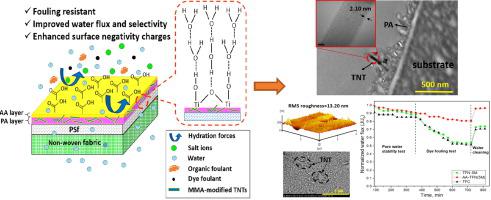Journal of Advanced Research ( IF 10.7 ) Pub Date : 2021-06-15 , DOI: 10.1016/j.jare.2021.06.011 Ying Siew Khoo 1 , Woei Jye Lau 1 , Yong Yeow Liang 2 , Mustafa Karaman 3 , Mehmet Gürsoy 3 , Ahmad Fauzi Ismail 1

|
Introduction
Nanomaterials aggregation within polyamide (PA) layer of thin film nanocomposite (TFN) membrane is found to be a common issue and can negatively affect membrane filtration performance. Thus, post-treatment on the surface of TFN membrane is one of the strategies to address the problem.
Objective
In this study, an eco-friendly surface modification technique based on plasma enhanced chemical vapour deposition (PECVD) was used to deposit hydrophilic acrylic acid (AA) onto the PA surface of TFN membrane with the aims of simultaneously minimizing the PA surface defects caused by nanomaterials incorporation and improving the membrane surface hydrophilicity for reverse osmosis (RO) application.
Methods
The TFN membrane was first synthesized by incorporating 0.05 wt% of functionalized titania nanotubes (TNTs) into its PA layer. It was then subjected to 15-s plasma deposition of AA monomer to establish extremely thin hydrophilic layer atop PA nanocomposite layer. PECVD is a promising surface modification method as it offers rapid and solvent-free functionalization for the membranes.
Results
The findings clearly showed that the sodium chloride rejection of the plasma-modified TFN membrane was improved with salt passage reduced from 2.43% to 1.50% without significantly altering pure water flux. The AA-modified TFN membrane also exhibited a remarkable antifouling property with higher flux recovery rate (>95%, 5-h filtration using 1000 mg/L sodium alginate solution) compared to the unmodified TFN membrane (85.8%), which is mainly attributed to its enhanced hydrophilicity and smoother surface. Furthermore, the AA-modified TFN membrane also showed higher performance stability throughout 12-h filtration period.
Conclusion
The deposition of hydrophilic material on the TFN membrane surface via eco-friendly method is potential to develop a defect-free TFN membrane with enhanced fouling resistance for improved desalination process.
中文翻译:

环保型表面改性方法开发具有改善的脱盐和防污性能的薄膜纳米复合膜
介绍
发现薄膜纳米复合材料 (TFN) 膜的聚酰胺 (PA) 层内的纳米材料聚集是一个常见问题,并且会对膜过滤性能产生负面影响。因此,对TFN膜表面进行后处理是解决该问题的策略之一。
客观的
在这项研究中,基于等离子体增强化学气相沉积 (PECVD) 的环保表面改性技术用于将亲水性丙烯酸 (AA) 沉积到 TFN 膜的 PA 表面,目的是同时最大限度地减少由纳米材料的掺入和改善反渗透(RO)应用的膜表面亲水性。
方法
TFN 膜首先是通过将 0.05 wt% 的功能化二氧化钛纳米管 (TNT) 掺入其 PA 层中来合成的。然后对其进行 15 秒的 AA 单体等离子体沉积,以在 PA 纳米复合材料层上建立极薄的亲水层。PECVD 是一种很有前途的表面改性方法,因为它为膜提供了快速且无溶剂的功能化。
结果
研究结果清楚地表明,等离子改性 TFN 膜的氯化钠截留率得到了改善,盐通过率从 2.43% 降低到 1.50%,而不会显着改变纯水通量。与未改性的 TFN 膜(85.8%)相比,AA 改性的 TFN 膜还表现出显着的防污性能,具有更高的通量回收率(>95%,使用 1000 mg/L 海藻酸钠溶液过滤 5 小时),这主要归因于其增强的亲水性和更光滑的表面。此外,AA 修饰的 TFN 膜在整个 12 小时过滤期间也表现出更高的性能稳定性。
结论
通过环保方法在 TFN 膜表面沉积亲水材料有可能开发出具有增强的抗污染性的无缺陷 TFN 膜,以改善脱盐过程。



























 京公网安备 11010802027423号
京公网安备 11010802027423号